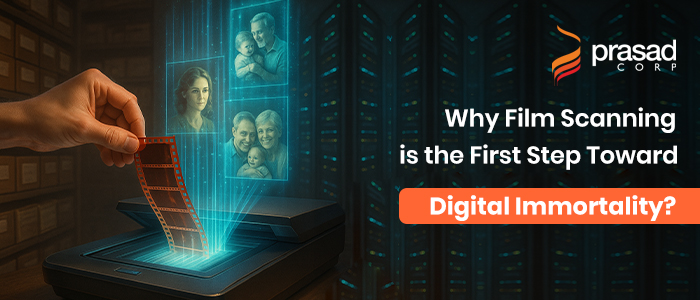The Fragile Legacy of Celluloid: Why It Cannot Last Forever
Reels of film, whether saved in dusty garrets, aging archives, or metal cans in studios, are more than just moving images. They are moments, memoirs, and milestones. As time ticks on, physical film deteriorates. Colors wane. Scratches multiply. Vinegar syndrome sets in. Without proper intervention, full visual histories risk being lost forever.
That’s where film scanning becomes not just valuable but crucial. In today’s digital world, digitizing old films is not just a specialized choice. It’s a cultural commitment. It’s how stories survive the test of time and how we step into a destiny where they can be seen, studied, and honored by the years to come.

Aging Film Is a Race against Time: What’s Ensuing Behind the Scenes?
Celluloid is a delicate material. The older the film, the more likely it is to cause irreversible deterioration. Temperature fluctuations, humidity, inadequate storage conditions, and chemical breakdown slowly erode the virtue of physical film reels. Even films conserved with caution in climate-controlled vaults are not immune.
This fragility is intensified in amateur or historical collections, documentaries, family reels, and regional cinema, many of which were never professionally archived. Once damaged, these films might become unprojectable or unwatchable.
Enter film scanning, a progressive technique that captures every frame, every grain, and every emotion in a captivating piece. With technologies such as 8K and 4K film scanning, even the smallest nuances are conserved with transparency never envisioned by the original filmmakers.
More Than a Copy: What Film Scanning Does
To the incompetent eye, digitizing old films might sound like merely moving a movie into a video format. It’s a detailed, frame-by-frame conservation effort. Each reel is scoured, scanned utilizing high-resolution equipment, and then digitally restored, often via technical film restoration services, to clear defects such as scratches, flickers, or color degradation.
Thanks to 8K and 4K film scanning, the digital versions built today often exceed the visual quality of original film projections. Details earlier lost in shadows or blown-out highlights are retrieved. More significantly, the content becomes accessible across all modern digital platforms, ideal for streaming, archiving, or even remastering. Digitization does not just replicate. It revitalizes.
The Digital Vault: Preserving for Generations, Not Just Decades
Why go through the effort of digitizing old reels? Because a digitized film is eternal. Once stored in the cloud, backed up on servers, and replicated across formats, its risk of being “lost” is practically zero, provided the digital archive is properly managed.
Unlike reels that degrade, digital formats can be upgraded and migrated as technology evolves. This adaptability is the foundation of what some call digital immortality. A scanned and restored film doesn’t just survive, it thrives. It can be reintroduced to audiences, reused in education, or reimagined in creative projects.
Film restoration services also play a vital role here. They ensure that what’s being archived isn’t just a damaged copy but a beautifully cleaned, color-accurate rendition, sometimes better than the original ever looked on screen.
Who Should Be Thinking About Film Scanning?
It’s not just for big film studios or national archives. The need for digitizing old films extends to:
- · Independent filmmakers: Save and disseminate your legacy work.
- · Cultural institutions: Protect legacy films, documentaries, and historical footage.
- · Families and collectors: Conserve cherished memoirs recorded on Super 8 or 16mm film.
- · Production houses: Remaster old content for OTT platforms in 4K or 8K resolution.
- · Academics and historians: Make research material efficiently available and searchable.
For all of them, film scanning is more than a technical process; it’s a gateway to continued relevance and accessibility.
From Celluloid to Code: A New Life for Old Stories
Physical film may have a shelf life, but the stories captured within it do not have to. Thanks to cutting-edge film scanning, what was once at threat of fading into anonymity now has a second chance at cultural value and commercial victory.
As the need for high-quality digital content grows, especially on platforms that need 4K and 8K film scanning, the value of early conservation becomes even more obvious. The films we digitize today may well be the reference points, educational tools, or cherished memoirs of tomorrow.
In the grand journey from analog to digital, digitizing old films is not the conclusive step; it’s the first and most important one toward immortality. And like all great openings, it begins with the determination to preserve. Not just for now, but forever.

